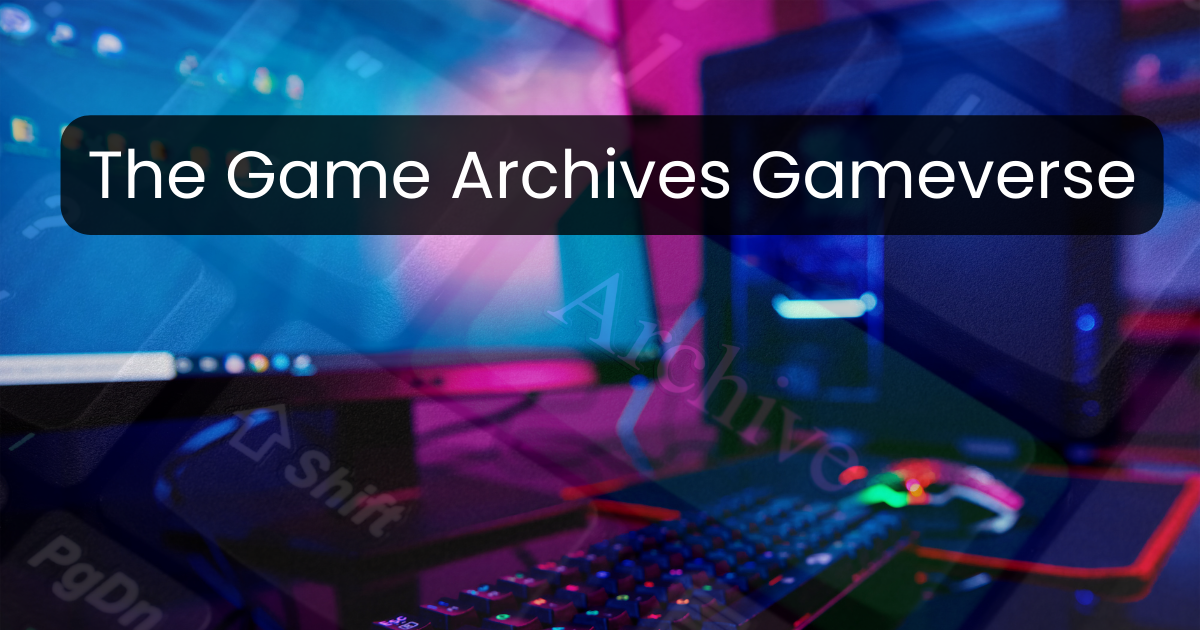In recent years, the gaming industry has experienced unprecedented growth, evolving from simple pixelated challenges to immersive virtual experiences. As this digital landscape expands, the need to preserve and explore the rich history of video games becomes more critical than ever. Enter The Game Archives Gameverse—a groundbreaking digital universe dedicated to safeguarding gaming heritage, fostering community engagement, and serving as a comprehensive resource for enthusiasts, developers, and researchers alike.
Understanding why The Game Archives Gameverse is essential in today’s gaming culture requires recognizing its role in document preservation, education, and community building. This article delves deep into the concept, features, architecture, significance, challenges, and future directions of this innovative platform, illustrating how it is shaping the future of video game preservation and scholarship.
What Is The Game Archives Gameverse?
Definition and Concept
The Game Archives Gameverse is a meticulously curated digital repository and interconnected universe designed to preserve, showcase, and provide access to the vast history of video games. It serves as a virtual museum and research hub, housing an extensive collection that includes classic titles, modern releases, indie projects, and multimedia content.
This platform not only archives individual games but also creates an interconnected network linking related titles, genres, developers, and gaming eras. It aims to emulate the complex web of gaming evolution, offering users a cohesive experience that reveals the cultural and technological shifts over decades.
Origins and Development
The roots of The Game Archives Gameverse trace back to early digital preservation projects initiated by gaming historians and archivists concerned about the fragility of game data and intellectual properties. Over the years, these initiatives evolved into comprehensive platforms due to advancements in digital storage, cloud computing, and community participation.
Key contributors include renowned game preservationists, developers, and organizations dedicated to maintaining gaming culture. These groups partnered to create a seamless platform that combines authoritative archival standards, user engagement, and innovative technology, transforming The Game Archives Gameverse into a central hub for game history.
Features of The Game Archives Gameverse
Extensive Game Library
The core strength of The Game Archives Gameverse lies in its vast game library. This includes:
- Classic and retro games: Titles from the early arcade and console eras, such as Pac-Man, Pong, and early Nintendo releases.
- Modern titles and indie games: The latest releases and small-scale indie projects that push creative boundaries.
- Compatibility across platforms: Games accessible on various systems, from PC to consoles and mobile devices, ensuring broad accessibility.
Interactive Digital Archives
The platform offers a rich multimedia experience, featuring:
- Developer interviews and design documents: Firsthand insights into game creation processes.
- Concept art and storyboards: Visuals that reveal creative development stages.
- Game soundtracks and trailers: Audio and video components to deepen appreciation and understanding.
Community and User Contributions
The Game Archives Gameverse fosters a participatory environment through:
- User reviews and ratings: Community-driven insights into game quality and significance.
- Mods and user-created content: Expanding the lifespan and customization options for games.
- Forums and discussion boards: Platforms for dialogue, sharing knowledge, and collaboration.
Educational and Research Tools
Educational features include:
- Game development tutorials: Resources for aspiring developers.
- Insights into gaming history trends: Contextual analyses of industry shifts.
- Access for academics: Research data and archival materials to support scholarly work.
The Architecture of the Gameverse
Database Structure
Ensuring easy access and organization, the database employs standard metadata practices for tagging games, developers, genres, and eras. Advanced search functionality allows users to filter and explore the repository efficiently, making discovery intuitive and comprehensive.
Integration and Interconnectivity
The Game Archives Gameverse excels at linking related content through:
- Series and franchise connections, such as the Super Mario or Legend of Zelda series.
- Developer profiles and timelines, providing historical context.
- Tagging genres and themes to facilitate thematic exploration.
This interconnected structure enables users to traverse gaming history seamlessly, discovering new facets of their favorite titles.
User Interface and Experience
The platform emphasizes user-friendly navigation, incorporating accessibility features that cater to diverse audiences. Personal libraries and favorites allow users to curate and revisit content effortlessly, enhancing engagement and learning.
The Significance of The Game Archives Gameverse
Preserving Gaming Culture
By protecting rare or endangered games, The Game Archives Gameverse ensures that important cultural artifacts are not lost to time. It chronicles gaming history, offering future generations a window into the technological and artistic achievements that have defined the industry.
Educational Impact
The platform supports academic research and learning initiatives, providing valuable resources for students and scholars. Aspiring game developers can learn from documented development processes, design principles, and industry trends.
Fostering Community and Collaboration
Connecting gamers, developers, and historians fosters a collaborative environment where knowledge flows freely. Initiatives like crowdsourced content and collaborative projects help keep the platform dynamic and evolving, making The Game Archives Gameverse a living repository of collective memory.
Challenges and Future Directions
Technical Challenges
Digital preservation faces hurdles such as:
- Emulation issues: Ensuring old hardware and software compatibility for playable archives.
- Copyright and licensing: Navigating legal frameworks to maintain open access while respecting creators’ rights.
Expanding the Archive
Future steps include incorporating emerging technologies such as virtual reality (VR) and augmented reality (AR) for immersive experiences. Additionally, expanding to include global gaming cultures, especially from underserved regions, will enrich the diversity of the archive.
Enhancing User Engagement
Innovations like gamification—adding badges, challenges, and rewards—could make exploration more engaging. Crowdsourcing efforts to gather community-generated content and updates will ensure the platform remains vibrant and comprehensive.
How to Access and Participate in The Game Archives Gameverse
Getting Started
Start by creating an account on the official platform. Once registered, users can navigate through organized categories, search for specific titles, or browse featured collections. Many sections are designed for easy exploration, even for newcomers.
Contributing to the Gameverse
Active users can submit their own discoveries, upload documentation, or share stories about their gaming experiences. Participating in forums fosters a vibrant community of passionate gamers and scholars.
Responsible Use and Preservation
It’s essential to respect copyright laws when sharing or downloading content. Advocating for preservation efforts and supporting open-source initiatives can help secure gaming history for future generations.
Key Points at a Glance
| Aspect | Details |
|---|---|
| Core Focus | Preservation, education, community engagement |
| Content Types | Games, art, soundtracks, interviews, tutorials |
| Key Features | Extensive library, multimedia archives, community tools |
| Technology | Database metadata, linking systems, user interface design |
| Challenges | Technical preservation, legal issues, technological obsolescence |
| Future Directions | VR/AR integration, global expansion, gamification |
Frequently Asked Questions (FAQs)
- What is The Game Archives Gameverse? It is a digital platform dedicated to preserving and showcasing video game history through an interconnected universe of games and multimedia content.
- How can I access the platform? By registering on the official website, you can explore, learn, and contribute to the archive.
- Is the content free? Most content is accessible at no cost; however, some premium features or downloads may require payment or permissions.
- How does the platform ensure the preservation of old games? Through digital archiving, emulation, and community support, it aims to protect and maintain access to vintage titles.
- Can I contribute content to The Game Archives Gameverse? Yes, community members can submit games, documents, and multimedia, fostering a collaborative environment.
- What future developments are planned for The Game Archives Gameverse? Future plans include integrating VR/AR experiences, expanding global coverage, and enhancing user engagement through gamification.
Conclusion
As the world continues to embrace digital entertainment, The Game Archives Gameverse stands out as a vital initiative to preserve and celebrate our collective gaming heritage. Its innovative structure, rich content, and community-driven approach make it an essential resource for gamers, developers, and scholars alike. By engaging actively with this platform, we contribute to safeguarding gaming history, fostering education, and inspiring future innovation. Whether you’re a casual player or a professional researcher, embracing The Game Archives Gameverse opens a portal to the past, present, and future of gaming culture.
Additional Resources
Stay tuned for upcoming events, webinars, and initiatives dedicated to expanding and enhancing The Game Archives Gameverse. Join the community, contribute your knowledge, and help shape the future of gaming preservation!





